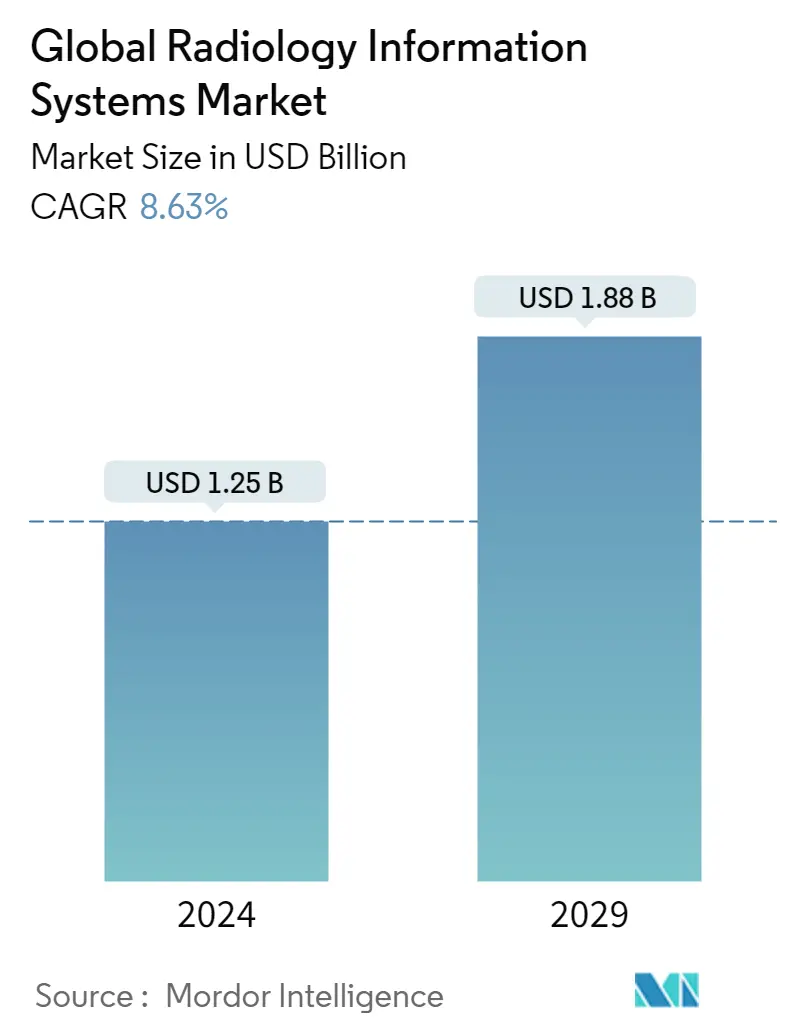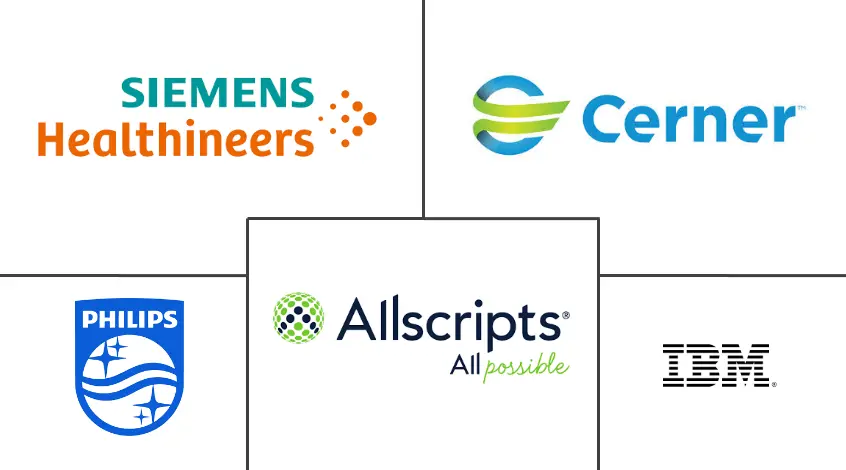Market Size of Global Radiology Information Systems Industry

| Study Period | 2019 - 2029 |
| Market Size (2024) | USD 1.25 Billion |
| Market Size (2029) | USD 1.88 Billion |
| CAGR (2024 - 2029) | 8.63 % |
| Fastest Growing Market | Asia Pacific |
| Largest Market | North America |
Major Players
*Disclaimer: Major Players sorted in no particular order |
Need a report that reflects how COVID-19 has impacted this market and its growth?
Radiology Information Systems Market Analysis
The Global Radiology Information Systems Market size is estimated at USD 1.25 billion in 2024, and is expected to reach USD 1.88 billion by 2029, growing at a CAGR of 8.63% during the forecast period (2024-2029).
COVID-19 is expected to have a significant impact on the radiology information system market. According to a research article "The Economic Impact of the COVID-19 Pandemic on Radiology Practices" published in the Radiological Society of North America in April 2020, the policy measures adopted to slow the transmission of COVID-19 were decreasing the demand for imaging services. The guidelines from the Centers for Disease Control and Prevention to postpone emergency outpatient visits during the height of the pandemic had a great impact on screening services such as mammography and lung cancer screening, and the impact has been observed throughout the sector, including interventional procedures. This is likely to have affected the demand for radiology information systems as they are used to analyze data from radiology units. With the current easing of norms and the start of vaccination programs, the market is expected to see a positive trend in a few months.
The major factors for the growth of the market include growth in the incidence rate of chronic diseases, improved access to healthcare information technology systems, and the increase in government funding for cancer-related research. Additionally, the burden of chronic diseases is on the rise across the globe, coupled with the rising aging population, and lifestyle-related disorders, such as cancer, arthritis, cardiovascular, and diabetes, are some of the primary factors responsible for the growth of this market.
According to the United Nations' World Population Ageing 2022 highlights, the share of the global population aged 65 years or above is projected to rise from 10% in 2022 to 16% in 2050. By 2050, the number of persons aged 65 years or over worldwide is projected to be more than twice the number of children under age 5 and about the same as the number of children under age 12. The geriatric population is highly prone to several complex and chronic diseases, which is expected to drive the demand for radiology services and have a positive impact on the studied market. According to Globocan 2020, an estimated 19,292,789 new cancer cases and 9,958,133 deaths due to cancers were reported in 2020 worldwide. An increase in cancer cases will lead to an increase in focus on radiology services for proper diagnosis, which is expected to drive the market demand for radiology information systems. The increasing incidence rate of chronic diseases like cancer is driving the demand for radiology information systems in the market.
As per a research article published in Eurostat Statistics July 2021, for CT scanners, there were 277 scanners in Belgium, 101 scanners in Ireland, 167 in Norway, and 85 in Serbia in 2020. For MRI scanners, there were 132 scanners in Belgium, 102 in Norway, 32 in Serbia, and 28 in Slovenia. The statistics also indicated that the number of CT and MRI scanners increased as compared to 2019, indicating growing demand for radiology procedures, thus boosting the demand for technologically advanced products and services and hence driving the radiology information systems market.
Additionally, the launch of new products and adoption of key strategies such as partnerships, investments, acquisitions, and others is expected to drive the studied market. For instance, in May 2022, FUJIFILM Healthcare Americas Corporation partnered with RAYUS Radiology and deployed Fujifilm's Synapse Enterprise Information System (EIS) as the workflow management solution for its comprehensive network of over 150 imaging centers across the United States. This indicates that the adoption of radiology information systems is increasing in developed countries such as the United States, thus leading to lucrative growth of the market.
An increase in radiology procedures, coupled with the increase in accessibility to these services, is expected to have a positive impact on the radiology information system market. However, the high cost of installation and scarcity of skilled labor is expected to hinder the market growth during the study period.
